#Corcoran Legacy Collection
Explore tagged Tumblr posts
Text
The Remarkable Life of Auctioneer Michael R. Corcoran
The Life and Legacy of Michael R. Corcoran On a recent sunlit morning, Michael R. Corcoran shared his insightful perspective on the cycle of life with a wry smile: “It’s doctor, undertaker, lawyer, then me.” At 96 years of age, Mr. Corcoran stands as a venerable auctioneer, running the esteemed Gustave J.S. White Estate Auctioneers in the picturesque coastal town of Newport, Rhode Island. Having…
#auction style#auctioneer#collectibles#community#estate auctions#Gustave J.S. White Estate Auctioneers#history#legacy#Michael R. Corcoran#Newport Rhode Island
0 notes
Text
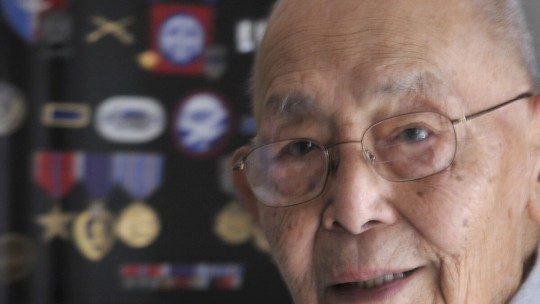
Captain Wesley Ko in front of his decorations for service with the 82nd Airborne Division during WW II. (Photograph courtesy of the Cape Cod Times).
Airborne Chinese American Warfighters on D-Day
On the occasion of the June 6 allied landings at Normandy in 1944, and every National Airborne Day on August 16, we honor three Chinese American veterans of the Second World War.
Glider Infantryman Wesley Ko
Wesley Ko served as a Captain in the 325th Glider Infantry of the 82nd Airborne Division in the European Theater (ETO), earning the Silver Star and numerous other medals including the Purple Heart.
Initially aspiring to be a pilot with the Flying Tigers, Wesley was working in a print shop in Philadelphia when the U.S. entered the war. Despite his employer offering him a draft deferment, he chose to enlist to join his friends. After completing officer candidate school at Fort Benning, Georgia, and overcoming initial delays in assignment possibly due to his Asian ancestry, he joined the 82nd Airborne and subsequently the 325th Glider Infantry Regiment.
During his thirty months of service, Ko fought in six major campaigns including action in Sicily, Naples, Normandy (the day after D-Day), the Battle of the Bulge, the Allied assault on the Siegfried Line, and the battle for Cologne. He was also present at the liberation of the Wöbbelin concentration camp at Ludwigslust.

Capt. Wesley Ko. Ko received the Silver Star for his service in the six major campaigns of the ETO and numerous other medals including the Purple Heart.
In his later years, Ko dedicated his time to preserving the legacy of the 325th Glider Infantry. He shared his experiences through interviews, articles, and books such as The Greatest Generation and his biography On Silent Wings of Courage. He also served as editor of The Glider Tow Line, a quarterly newsletter dedicated to the glider men's stories.
In addition to his military service, Ko co-owned and operated Komak, Inc., an electronics company, with his brother David for 45 years. He had a wide array of interests including computers, boating, fishing, family, poetry, and furniture re-finishing and building.
Ko passed away in E. Falmouth, Mass., on Dec. 15, 2012. He was 93.
Leon Yee: San Francisco Chinatown’s Own
On the night of June 5, 1944, private First Class Leon Yee had found his way onto a paratroop transport plane, flying toward the coast of France. Having grown up in San Francisco Chinatown, Yee had volunteered for the paratroopers in early 1942. He had been motivated by the $50 bonus in hazardous duty pay, which he needed to support his family. After completing jump school at Fort Benning and earning his wings in mid-1942, he trained as a demolition expert and member of H Company in the 507th Parachute Infantry Regiment of the 82nd Airborne Division. According to Chinese American military historian, Montgomery Hom, Yee had concealed from his family how dangerous his duties were. “He tried to hide his combat status by telling his mother he was going to be working with planes,” Hom has written. “But in truth, he was going to be jumping out of planes as an airborne soldier.”
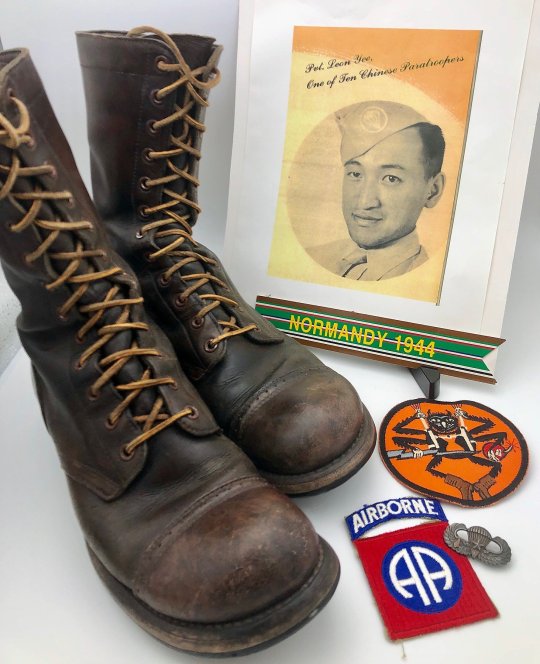
Leon Yee's jump boots, unit patches, and jump wings (from the collection of his nephew and documentarian, Montgomery Hom). The boots were designed initially in 1941 by William P. Yarborough, a test officer in the 501st Parachute Infantry Battalion/Provisional Parachute Group. They are also known as "Corcorans," after the J. F. Corcoran Shoe Company, one of their manufacturers.
At approximately 0200 on June 6, and as part of the then-largest airborne operation in human history, Yee hurled out of his plane, weighed down by more than 100 pounds of equipment, As he descended, he saw sporadic gunfire and small fires on the ground. He landed in a cow pasture northwest of the Merderet River, disoriented in the pitch-black night. under the cover of darkness. German anti-aircraft fire illuminated the sky, hitting some of the aircraft.
After landing without mishap and shedding his parachute harness, Yee took cover in a nearby ditch. He had no idea of his location, as his regiment had experienced the worst drop pattern of all the American airborne units, with only 20% of the paratroopers landing in their designated zones. Hours later, by 4 a.m., a helmetless sergeant from another company of the 82nd Airborne Division joined him. Together, they sat quietly in the ditch until dawn, trying to determine their location. They discovered they were north of their intended drop zone.
By daylight, Yee had joined other regrouped paratroopers regrouped to plant explosives to destroy enemy communication lines, and engage in firefights as elements the 82nd advanced over the next few days toward their main objective, about 5 miles from Utah Beach -- the marshes of the Merderet and Douve. The marshes formed a natural defensive line protecting the western end of the Allied amphibious landing zone. However, the flooded marshes also limited the Allies' potential to break out of the beachhead. They had been flooded to further impede movement. Allied planners deemed control of the bridges at Manoir de la Fière and Chef-du-Pont as vital.
Yee's ad hoc unit reached the La Fière area, and over the next five days attempted to seize causeways and bridges over the Merderet at La Fière and Chef-du-Pont and, further, destroy the highway bridge over the Douve River at Pont l'Abbé (now Étienville). The lightly-armed troops of the 82nd faced counterattacking Wehrmacht units supported by Panzer III and French tanks captured four years earlier.
Yee would see intense combat for five days. During an attack on a German machinegun position, he was severely wounded. A burst of gunfire had struck rocks in front of him, and a ricocheting fragment hit his right temple, just below his helmet. Bleeding profusely from his wound, he lost consciousness. Yee awoke on a cot in a landing craft headed back to England.
Paratrooper Kenneth Gong
On the eve of D-Day Kenneth Gong, a native Chinese American from the town of Cleveland in the Mississippi Delta, performed the first of his two combat jumps, with the 101st Airborne Division.
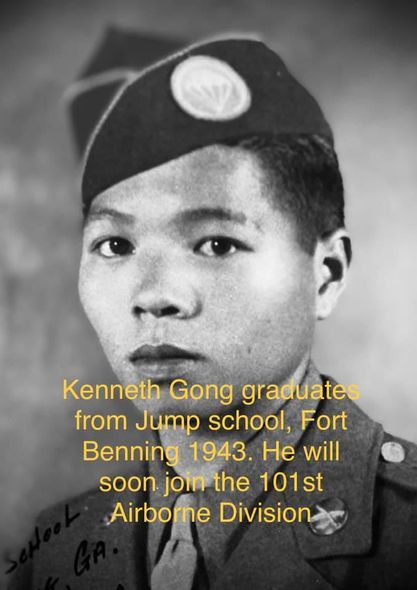
Sgt. Kenneth Gong of the 101st Airborne Division was a native of Cleveland, Mississippi.
Kenny Gong had earned the nickname “Machine Gun Gong” for his proficiency in firing the M3 submachine gun.
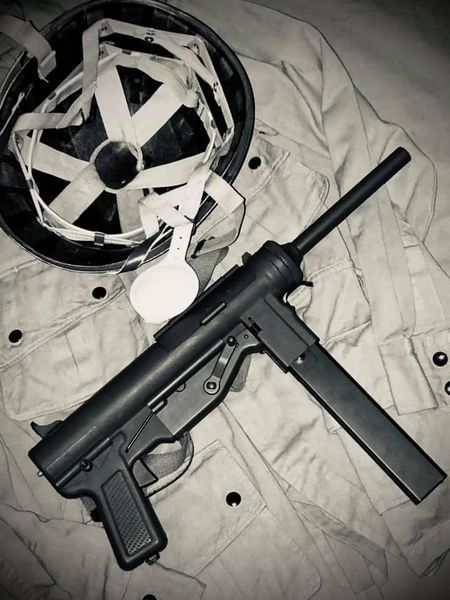
The M3 is an American-made, .45-caliber submachine gun adopted by the U.S. Army in late 1942, as the "United States Submachine Gun, Cal. .45, M3." The M3 was chambered for the same .45 ACP round fired by the Thompson submachine gun, but was cheaper to mass produce and lighter, at the expense of accuracy. Troops commonly referred to the firearm as the "Grease Gun" or "the Greaser" owing to its visual similarity to the mechanic's tool. The weapon is often attributed as the source of the WW II slang used by American soldiers in referring to enemy troops killed by this weapon, who were referred to as having been "greased."
T-4 Sergeant Gong was assigned to the headquarters command, 3rd battalion, 501st Parachute Infantry Regiment, 101st Airborne Division. He saw combat in Normandy and Holland.
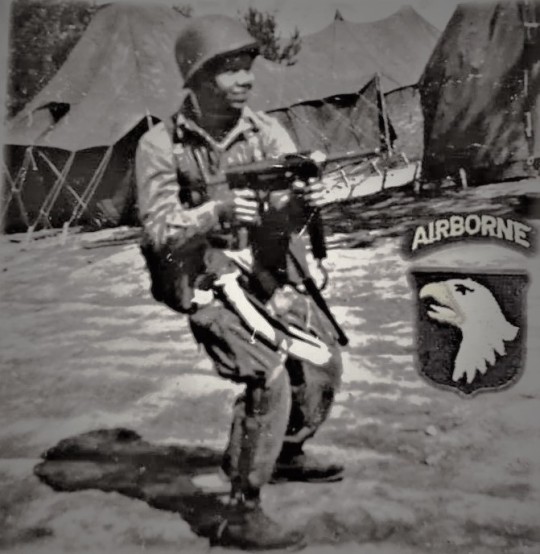
Sgt. Kenneth Gong of the 101st Airborne Division brandishing the M3 submachine gun, his handling of which would earn him respect from his comrades.
When US president Bill Clinton proclaimed October 26, 1998, Chinese Veterans of World War II Day, longtime Delta resident Kenny Gong was one of the White House honorees. His division’s motto remains “Rendezvous With Destiny.”
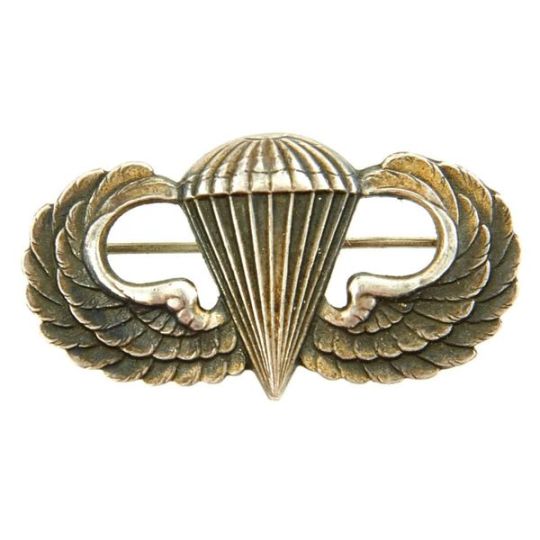
The Parachutist Badge, also commonly referred to as "Jump Wings," is a military badge of the United States Armed Forces. Some services, such as the Marine Corps, officially refer to it as an insignia instead of a badge. The original Army Parachutist Badge was designed in 1941 by Captain (later Lieutenant General) William P. Yarborough and approved by the Department of War in March of that year. The Parachutist Badge replaced the "Parachutist Patch" which had previously been worn as a large patch on the side of a paratrooper's garrison cap. (LTG Yarborough also designed the Senior and Master Parachutist Badges and the addition of stars to portray the number of combat jumps.) The airborne background trimming that is worn behind the badge of those assigned to airborne units is also a contribution of Yarborough.
On this 80th anniversary of the airborne landings in Normandy, let us honor not only the approximately 10 Chinese Americans who served with paratroop and glider units in the European Theater of Operations but all who answered the call to fight for their country during an era of exclusion and segregation.
They also served.
---------------------------------
To read more about Chinese America's warfighters of that era from California, Montgomery Hom's book Fighting on all Fronts - Profiles of WWII Chinese Americans from the Golden State may be purchased here.
#Chinese American airborne troopers#Kenneth Gong#101st Airborne Division#Wesley Ko#82nd Airborne#Leon Yee#Montgomery Hom
3 notes
·
View notes
Text
Rubell Museum - DC - Jan 13 2024
A trip to the Rubell Museum was something to look forward to despite my new Doc Martens slicing up my ankles during my 10-minute walk from the Waterfront Metro station. Opened on Oct 29th, 2022, the DC location at 65 I St. SW brought Mera and Don Rubell's collection of post-1980 art from Miami to the DC's Southwest neighborhood. This would be my second time visiting with my first experience viewing the inaugural exhibition What's Going On?. The collection showcased many artists I was not familiar with. It was a treat discovering new and exciting art. For me, artists that I wanted to learn more about from my last visit were Chase Hall, Hernan Bas and Christina Quarles.

Christina Quarles
Detail: Fell to Earth (Felt to Pieces), 2018
Acrylic on Canvas
Taking advantage of the gorgeous and expansive space past the entrance, the museum mounted works by Alexandre Diop - a Franco-Senegalese artist who, according to the website, "uses discarded objects to create work that raises questions pertaining to sociopolitical, cultural and gender issues. Drawing inspiration from his European and African roots, he explores the legacies of colonialism and diaspora while tackling universal themes of ancestry, suffering, and historical violence". The open space with its large cathedral-esque windows floods the space with natural light, showcasing all the wonderful varied textures and highlighting all the materials that Diop uses in his work.

Once you exit this room, you will enter a three-level building that was once part of Randall Junior High School, a historically Black public school that ceased operations in 1978. The Rubells purchased this historic site from the Corcoran College of Art and Design in 2010 for $6.5 million. The building was the site for the inaugural What's Going On? when the museum opened in 2022.
Although quite disorienting to navigate at first, each level essentially follows a radial floor plan. There will be an exhibit in the middle of the level when you first come, and then out in all directions are hallways that will lead to individual rooms with their own exhibits relating to the overall current exhibition - Singular Views: 25 Artists.
One of the biggest flaws in the architecture of the building or more importantly, how the architecture is utilized, is the decision to install art in the narrow hallways. These hallways doubtfully will pass the modern fire and safety code. Large enough to fit one individual through, there would often be two-dimensional works hanging on both sides of the wall. The proximity between the visitors and the works would make any conservator nervous. There is a serious bottleneck where a visitor must wait for another to pass through before entering these spaces. Needless to say, when there is a person waiting, one cannot help but exit in a hurried manner. This takes away any chance for close looking or truly connecting and appreciating the work.
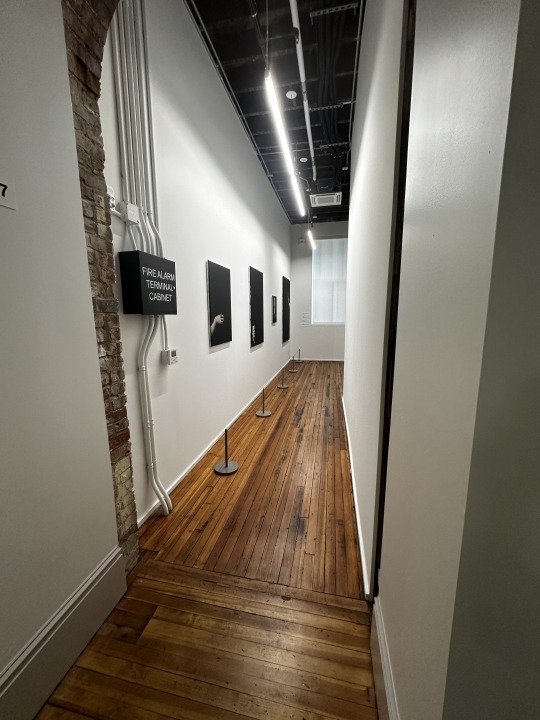
Overall, the exhibition was something you would come to expect of the Rubell Museum (so far that I have seen in DC): colorful, vibrant, electric and featuring young artists, some in their early or mid careers. The standouts this time for me were Amoako Boafo, Otis Kwame Kye Quaicoe and Rozeal, whom I will be covering in separate posts so they each have their own spotlights.
2 notes
·
View notes
Text

Low - Johnny Brenda's, Philadelphia, Pennsylvania, February 1, 2016
Feels as though you can't go more than a day these days without hearing that another great musician has passed away. Mimi Parker of Low is a particularly tough one, since she was so young.
"I’ve always imagined Parker singing as if she can see everyone and everything all at once, like she’s performing from atop the clouds—not so much a deity as much as a guardian angel," writes Nina Corcoran. "No wonder she had such a level-headed approach to it all. When you zoom out far enough, your perspective shifts. Worries are still worries and pain is still pain, but in the context of everything around them, the things that stress us out become less urgent. Patience becomes a grounding tool. Understanding becomes a great unifier. And love, in all of its forms, reinstates itself as the reason we’re alive in the first place. It’s the roadmap of where to go next."
Where to go next? Well, Low fortunately left behind a sizable legacy of amazing music — including a healthy collection of live recordings on Archive.org. But here's something that's not up there just yet: Sebastian Petsu's tape of the band a few years back in Philadelphia. A terrific show overall, highlighted by the Parker's encore performance of Al Green's classic "Let's Stay Together," an oddly perfect choice. Maybe she wasn't a soul singer in the typical sense of the term, but Mimi was a Soul Singer.
Sign up for the Doom & Gloom From The Tomb Substack newsletter — Doom & Gloom delivered to your inbox every Friday!
15 notes
·
View notes
Photo


Andrea Cowch
* * * * *
Andrea Kowch's work could be described as the creative legacy of Andrew Wyeth and Alfred Hitchcock. Her haunting rural settings mask mysterious backstories. But Kowch has invented her own brand of powerful, moody symbolism with enigmatic, unfathomable characters, a rich autumnal color palette, and tense, mysterious scenes. “It's almost like characters on a stage,” she said. “So each image is a story that I just want people to delve into and explore.”
Inspired by the sweeping Midwestern American landscapes and architecture of her home state of Michigan, Kowch's work reflects Northern Renaissance and American art influences. The carefully composed paintings achieve a three-dimensional quality that draws viewers into the action.Kowch's paintings feature up to four friends who model for her allegorial scenes using the palette and metaphors of the seasons and weather of her beloved Michigan. The women's inscrutable expressions hide their true emotions, while their windswept hair hints at feelings that might be surging underneath a controlled exterior.
Domestic and wild inhabitants vie for attention: Dogs, chickens, rabbits, quails, moths, water fowl, and other animals-many with historical allegorical meanings-coexist with the women. The haunting, dreamlike scenarios evoke both melancholy and nostalgia, giving the work an ambiguous and suspenseful edge.“
The lonely, desolate American landscape encompassing the paintings' subjects serves as an exploration of nature's sacredness and a reflection of the human soul, symbolizing all things powerful, fragile, and eternal,” Kowch wrote in her artist statement.
Born in Detroit, Michigan in 1986, Kowch graduated summa cum laude from the College for Creative Studies in 2009 with a BFA in illustration. Beginning with the prestigious Scholastic Art Awards and the National Young Arts Foundation (formerly the National Foundation for Advancement in the Arts) in her early adulthood, her work has been honored and recognized at the Corcoran Gallery of Art in Washington, D.C., New York City's Diane von Furstenberg Gallery, and the Margulies Collection at the Warehouse in Miami, Florida.
Kowch has since gone on to receive best of show awards in various juried exhibitions of regional, national, and international caliber, and has exhibited at museums and galleries, including solo exhibitions at the Muskegon Museum of Art, the Richard J. Demato Fine Arts Gallery in Sag Harbor, New York (which exclusively represents her work), Grand Rapids Art Museum in Michigan, ArtPrize, Art Basel Miami, the Los Angeles Art Show, ArtHamptons, and SCOPE New York, which selected Kowch as one of the top one hundred emerging artists in the world in 2012. She has also been featured in and graced the front covers of several publications, including Spectrum, Direct Art, American Art Collector, Revue, and Southwest Art.
Kowch's work can be found in many significant private collections worldwide and in public collections, including the Muskegon Museum of Art in Michigan, Grand Rapids Art Museum, Northbrook Library in Illinois, and the Brooklyn Art Library in New York. Kowch resides and works in Michigan as a full-time painter and adjunct instructor at the College for Creative Studies.
[Celebration of Female Artists in History]
6 notes
·
View notes
Text
Opening Today—Gagosian to Present Paintings by Neil Jenney in New York
Gagosian to Present AMERICAN REALISM TODAY Paintings by Neil Jenney from His Modern Africa and Good Paintings Series
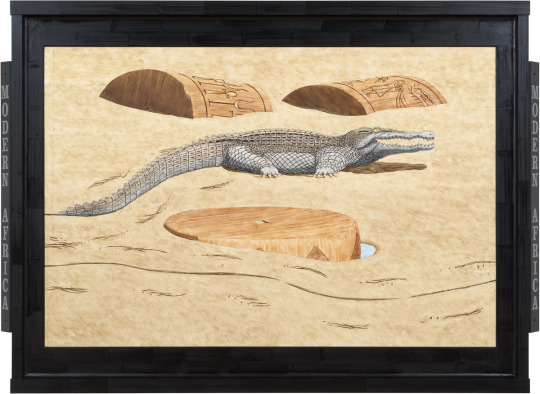
I’m governed by nature. Anything I do, I want it to feel natural. —Neil Jenney NEW YORK, November 9, 2021—Gagosian is pleased to present paintings by Neil Jenney from his recent series Modern Africa (2015–)—a subseries of the New Good Paintings (2015–)—and the preceding series, Good Paintings (1971–2015). Jenney is committed to exploring, and ultimately transcending, realism as both style and philosophy—a project first sparked by the preponderance of Pop-themed Photorealism in late-1960s New York. Having designated his early work “Bad Painting” (a term coined by Marcia Tucker, director of the New Museum, New York, in 1978) and his output after 1970 “Good Painting,” he continues to challenge familiar models of taste and subject matter while pursuing a meticulous and highly idiosyncratic approach to the representation of culture and place. As with proto-Surrealist writer Raymond Roussel’s fanciful travelogue Impressions d’Afrique (Impressions of Africa, 1910), Jenney’s approach to his subject in the paintings on view is rooted in personal imagination, and in Western fantasies about the continent. Although these paintings are landscapes, they eschew sweeping panoramas in favor of more intimate, even introspective scenes. But despite his pictorial restraint, Jenney’s series addresses fundamental conflicts between nature and civilization, and reflects a concern with our deteriorating environment. Modern Africa shows architectural fragments that Jenney characterizes as “utilitarian”—columns, ramps, and stairways—half-submerged in undulating sand dunes. These monumental structures seem to exist in past and future simultaneously, providing both a critical look at the legacies of colonialism and a speculative view of what may lie in wait for humanity should we fail to address climate change. While the shadows and footprints that intrude here and there reveal a continued human presence, no figures are visible, suggesting that Jenney’s envisioned world is incapable of supporting many survivors. Jenney refers to his work as “painted sculpture,” and uses handmade black wooden frames, which he first designed in the early 1970s, to present canvases executed in a crisp, high-contrast style. This device was inspired by the classical Greek notion of viewing a painting as a scene through a window, an idea that he encountered in a Fourth Avenue bookstore. Providing in this way an “architectural foreground” as well as—through their stenciled captions—a guide to title and setting, the frames situate the paintings as objects and interpretations and continue to provide Jenney with what he has described as “the most stimulating prospect” with which he has ever worked. Neil Jenney was born in 1945 in Torrington, Connecticut, and lives and works in New York. Collections include the Metropolitan Museum of Art, New York; Museum of Modern Art, New York; Whitney Museum of American Art, New York; Los Angeles County Museum of Art; Louisiana Museum, Humlebæk, Denmark; and Tate, London. Solo exhibitions include Paintings and Sculpture 1967–1980, University of California Art Museum, Berkeley (1981, traveled to Contemporary Arts Museum, Houston; Corcoran Gallery of Art, Washington, DC; Stedelijk Museum, Amsterdam; Louisiana Museum, Humlebæk, Denmark; and Kunsthalle Basel); Collection in Context—Neil Jenney: Natural Rationalism, Whitney Museum of American Art, New York (1994); and North America, Aldrich Contemporary Art Museum, Ridgefield, CT (2007). Jenney’s work has been featured in major group exhibitions and biennials, including the Whitney Biennial (1969, 1973, 1981, and 1987); Representations of America (1977–78, organized by the Metropolitan Museum of Art, New York, and the Fine Arts Museums of San Francisco for the Pushkin Museum, Moscow; Hermitage, Saint Petersburg; and Palace of Art, Minsk, Belarus); New Image Painting, Whitney Museum of American Art, New York (1978); and Bad Painting, New Museum of Contemporary Art, New York (1978). NEIL JENNEY AMERICAN REALISM TODAY Opening reception: Tuesday, November 9, 4–7pm November 9–December 18, 2021 976 Madison Avenue, New York _____ Neil Jenney, Modern Africa #4, 2020–21, oil on canvas, in painted wood artist’s frame, 72 1/4 × 95 1/2 × 3 1/4 inches (183.5 × 242.6 × 8.3 cm) © Neil Jenney. Photo: Rob McKeever
3 notes
·
View notes
Text
Warrior Season 2 Episode 3 Review: Not How We Do Business
https://ift.tt/2T1QvlP
This Warrior review contains spoilers.
Warrior Season 2 Episode 3
“Not How We Do Business” sums up the latest episode of Warrior in two ways. First, it’s a line that Zing (Dustin Nguyen) lays on O’Hara (Kieran Biew) when he finally breaks away from being a debt collector for the Fung Hai. “Not how we do business” also works on a meta level, this episode only has one Kung Fu fight. That’s weak for a Bruce Lee inspired show. There are two other fight scenes, but they’re scrappy brawls the likes of which can be found in any action drama.
Bruce Lee fans want Kung Fu, and not just any Kung Fu. As part of the Little Dragon’s legacy, it must be great Kung Fu. The lone Kung Fu scene in this episode is good and serves to introduce a pivotal new character, but that’s not enough. It’s not how we do business.
This episode begins with a missed opportunity where Ah Sahm (Anthony Koji) is in the Barbary Coast Fight Pit, facing off against another challenger. That would be great, but the fight is already over. The opening shot focuses upon his burly challenger, but he has already been knocked out and is just standing stunned, then there’s a shot of Ah Sahm, and then the challenger falls.
Seriously? No Kung Fu? Starting in the Fight Pit is fine dramatically but shortchanging the audience out of a fight is not the way to go for this show. It’s a big ripe piece of low hanging fruit left to rot. Bruce Lee fans crave gratuitous Kung Fu. Whenever Warrior goes to the Fight Pit, there had better be a fight.
After that, Ah Sahm’s fight manager Vega (Maria-Elena Laas) teases him with the promise of a bigger purse in some other international arena, a place where Warrior will hopefully go at some point this season, but not in this episode. Chao (Hoon Lee) pulls Ah Sahm aside and implies that he knows about the molasses plot that he and Young Jun (Jason Tobin) are cooking up, and that he’s concerned over Ah Sahm’s rivalry with Mai Ling (Dianne Doan). Chao comments “I don’t see any version of that ending well” which comes as no surprise to anyone. If this all ended well, there’d be no fight scenes.
Enter Hong – the New Guy in the Hop Wei
The centerpiece of the episode is the introduction of a new character, Hong (Chen Tang). Chen Tang just portrayed Yao in the new Mulan. In the original Disney animated film, Yao was Mulan’s hard ass comrade, and in contrast, he’s the shortest character (unless you count Mushu and Cri-Kee). The live action Mulan changed a lot – Yao was still the hard ass, but now he’s 6 feet tall and a less significant role. Nevertheless, Chen is a great addition to Warrior, exuding a southern charm because he was raised in Memphis and has a natural southern accent in real life, but he covers that up for Warrior.
Read more
TV
Warrior Season 2 Episode 1 Review: Learn to Endure, or Hire a Bodyguard
By Gene Ching
Hong arrives ‘fresh off the boat’ with a batch of new recruits, hatchet men ordered from China by Father Jun (Perry Yung). Their appearance makes Young Jun nervous that Father Jun might be on to his non-Chinese molasses scheme. He’s also suspicious of Hong’s attempts to weasel his way in with them. Nonetheless, Young Jun and Ah Sahm agree to take Hong to a brothel. There Ah Sahm discovers Hong is gay but sympathetically keeps that secret.
After that, the threesome stumble across some Fung Hai gangsters in the streets and Hong, either eager to impress or just hungry to kick some ass, takes them all out by himself. It’s a good introduction and reveals his expertise with whip chain. A whip chain is a traditional Chinese weapon, one that can be easily concealed as a trusty everyday carry for a Tong man. Chen Tong delivers a decent first fight scene with it. As weapons go, the whip chain requires more skill to wield than a nunchaku. Hong deploys both the whip chain’s striking and entangling methods proficiently, although the scene is in a dark alley and the shadows can conceal a multitude of sins. Chen Tong lists skills in Stage Combat, Karate, Kung Fu and Tai Chi on his resume and claims he did some preparation for the role of Hong studying Chinese whip chain and the Japanese equivalent manriki-gusari.
One of the best things about Warrior is the relationship between Ah Sahm and Young Jun. They have an earnest chemistry as two gangsters being gangsters, delivering beat downs, slinging molasses, and chasing sticky. This camaraderie is commonplace for buddy films and TV partners but it’s exceedingly rare and delightfully refreshing to see this for two Asian men in a Western production. Both Ah Sahm and Young Jun have a lot to prove and their connection is palpable. Hong brings a new lighter tone as the third wheel to their partnership. They already seem to be bonding as a threesome which is promising for the rest of the season.
In the Room Where It Happens
Mai Ling (Dianne Doan) and Li Yong (Joe Taslim) pay a visit to the Fung Hai lair so she can scold Zing (Dustin Nguyen). Walking into Zing’s room is a gutsy move for Mai Ling, but with Li Yong at her side, she’s fearless. Zing agrees to Mai Ling’s terms, but not before she shares a ritual drink of mare’s milk with him. Mare’s milk, or Kumis, is a unique fermented drink because few alcoholic beverages are dairy derived. It’s usually not that strong, nor is it the disgusting chunky chowder depicted in Warrior but the Mongols are stereotyped as barbarians, just as they were in Mulan, so it’s depicted as revolting. Mongolians are poorly represented in film and television. Project their media depictions upon any other race and the generally disparaging tone is evident.
On the way out, a Fung Hai thug gets up in Li Yong’s face and gets throat punched for his trouble. Don’t mess witjj Li Yong. Knowing Li Yong could destroy his crew, Zing calls off his man saying “Be thankful for your pain. It means you’re still alive.”
Much to Li Yong’s dismay, Mai Ling echoes this line towards the end of the episode, making him wonder if his boss is headed down the wrong path like Zing. While everyone in Warrior has their dark side, Zing has emerged as the villain with no redeemable qualities. Taslim brings a guarded nobility to Li Yong as Warrior’s most badass fighter; he’s loyal to Mai Ling, his lover and boss, but not blindly so. This, along with Taslim’s martial expertise, makes Li Yong one of the more intriguing characters. Mai Ling, like most of the rest of the cast, is another character with a lot to prove.
Read more
TV
Warrior Episode 2 Review: There’s No China in the Bible
By Stephen Harber
Movies
Best Martial Arts Movies on Amazon Prime Right Now
By Gene Ching
Later, Zing, being the barbarous Mongol villain, threatens Chao (Hoon Lee) over delivering weapons. Chao, always the manipulator, discusses Zing with Mai Ling. Then later, Chao meets with Li Yong alone. Over bowls of noodles, Chao proposes a way to avoid war, teasing some coming intrigue to take Zing down. Everyone is aligning against Zing and the anticipation of this inevitable showdown is promising.
Sophie (Celine Buckens) sneaks into Leary’s (Dean Jagger) back room at the Banshee and finds his map of factories that use coolies. While she’s smart enough to realize that Leary is behind the factory firebombing, she somehow overlooks that Mercer Steel has got to be among those circled on that map too. Clearly her sister’s company is on the Irish workers hit list because they were beating up the coolies headed to Mercer until Penny (Joanna Vanderham) hired the Hop Wei for protection against them. Sophie and Leary finally hook up and Leary unwittingly echoes Chao saying, “This isn’t going to end well.” By now, the audience is well aware it’s not going to end well and has their collective fingers crossed that it will end in a massive Kung Fu fight at the very least.
As they have a post-coital stroll, Sophie suggests that Leary get into politics with a nod to Hamilton by suggesting he should “be in the room where it happens.” Leary calls Sophie out when she says she “knows.” She’s an entitled upper-class woman and hasn’t seen the tragedy that Leary has. He tells Sophie of some of the horrors he witnesses, of friends and family starving, and starts to pull away from her until she draws him back. It gives Leary more context.
Given the era, Leary likely escaped the Great Irish Famine (1945-1849). Over a quarter million Irish emigrated to the New World and Leary would be part of that generation. The Irish are struggling too. During that period, Irish immigrants made up most of San Francisco’s working class and about one-third of the city’s population. This is another way Warrior sheds light upon a dark period of history.
Police Beatdowns
The other two fight scenes come from the cops. The first is short. Lee (Tom Weston-Jones) returns to Nora’s (Gaosi Raditholo) tavern where he got rolled last episode to exact revenge. He goes full copper, night-sticking and shooting up the joint until he gets his cash back. With Lee, Weston-Jones is echoing his role as Kevin “Corky” Corcoran, in his previous TV show Copper. Corky was an Irish detective in a period drama set in the late 18th century, the same era as Warrior. This is not so much of a bar fight as it is a cop taking out a few unarmed barflies.
When a debtor’s wife flashes a gratuitous boob at O’Hara, offering him sex to pay her husband’s bills to the Fung Hai, it’s the last straw and he finally quits the Fung Hai. Even though O’Hara has repaid his debt, Zing exacts revenge by sending Tong men to invade his home and threaten his family. This happens right after dinner where Lee had been their guest. Lee comes to the rescue, revolver blazing, and a scrappy bit of violence ensues where O’Hara’s son and wife must defend themselves too. It’s a brutal sanguineous scene, leaving everyone dead or splattered with blood, ending this episode in a bloody mess.
Warrior Season 2 can be seen exclusively on CINEMAX.
cnx.cmd.push(function() { cnx({ playerId: "106e33c0-3911-473c-b599-b1426db57530", }).render("0270c398a82f44f49c23c16122516796"); });
The post Warrior Season 2 Episode 3 Review: Not How We Do Business appeared first on Den of Geek.
from Den of Geek https://ift.tt/354XdNI
2 notes
·
View notes
Text
]The Gifts of Tony Podesta, American University Museum, 26.1.19
]The Gifts of Tony Podesta, American University Museum: ab 26.1.19 zeigt Darren Almond, Jake & Dinos Chapman, Jenny Gage, Mads Gamdrup, Anna Gaskell, Margi Geerlinks, Siobhán Hapaska, Mwangi Hutter, ..
26. Januar bis 17. März 2019: Diese erste große Ausstellung der Corcoran Legacy Collection zeigt starke Fotografien und Skulpturen, die Tony Podesta im letzten Jahrzehnt der Corcoran Gallery of Art gespendet hat, welche jetzt zum Bestand des American University Museum gehört. Podesta hat den Ruf, ein beherzter Unterstützer der zeitgenössischen Kunst vorrangig von Frauenzu sein. Er ist ein…
View On WordPress
#American University Museum#Ann-Sofi Sidén#Anna Gaskell#Anneè Olofsson#Barbara Liotta#Clare Langan#Corcoran Legacy Collection#Darren Almond#Ernesto Neto#Galerie Burster#Gyan Panchal#Hellen van Meene#Jake & Dinos Chapman#Janaina Tschäpe#Jennifer Sakai#Jenny Gage#Jenny Rydhagen#Jone Kvie#Justine Kurland#Katja Strunz#Katzen Arts Center#Klaus Ottmann#Mads Gamdrup#Malerie Marder#Margi Geerlinks#Mwangi Hutter#Nira Pereg#Ottonella Mocellin#Patricia Piccinini#photography
0 notes
Text
DYSTOPIA SCI-FI CON COMES TO LOS ANGELES CONVENTION CENTER FOR INAUGURAL LAUNCH IN NOVEMBER
Three-Day Event Hosts West Coast Edition of The 8th Annual Philip K. Dick Sci-Fi Film Festival
Star Trek Veteran Tim Russ and Oscar-Winning Makeup Artist Barney Burman Among Celebrated Artists and Filmmakers Set To Appear

Beyond belief lies the heart of science fiction and this fall, fans of the genre will assemble at the inaugural Dystopia Sci-Fi Con, a new interactive event featuring a cinematic lineup of sci-fi, cyberpunk, virtual reality, and future noir alongside special guests, panels, exhibitors, and more. The gathering will also host the first half of The 8th Annual Philip K. Dick Science Fiction Film Festival, a thriving platform for independent film in honor of acclaimed novelist Philip K. Dick. A number of celebrated actors, filmmakers, and speakers will appear including David Brin, Barney Burman, Elizabeth Karr, Julianna Robinson, Tim Russ, Saku Sakamoto, M.D. Selig, and John Alan Simon. Held at the Los Angeles Convention Center, the event will run from November 8-10, 2019.
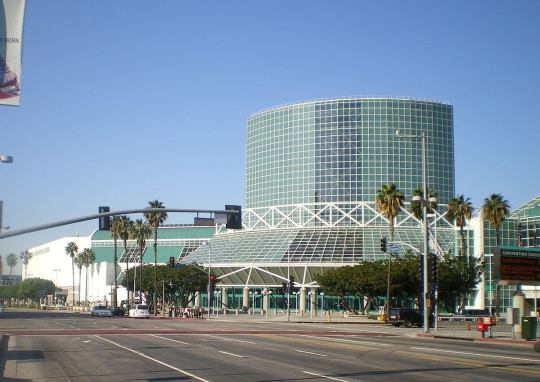
Theorized that science fiction is the science of tomorrow, Dystopia Sci-Fi Con will serve as a captivating observation into the future. “Dystopia refers to a world out of balance where the human spirit is crushed under the weight of monopolistic corporations,” said organizer Daniel Abella. “Our event is a fascinating way of watching how our lives will be affected by what is to come.” With a slate of activities highlighting feature and short films, cosplay, and guests from across the genre’s spectrum, Abella promises an enjoyable and satisfying occasion. “We are brining back the look and sound of traditional sci-fi cons,” he said. “In such a welcoming environment, fans can express their interests and feel more connected to everything they love about sci-fi.” As the West Coast home for The Philip K. Dick Science Fiction Film Festival, screenings will be held as part of its eighth annual outing that continues in New York City in March 2020. “Philip K. Dick created the modern spirit of rebellion through his questioning of a world run by conformity,” said Abella. “His work centered on the plight of humans keeping their dignity in the face of a dehumanized world and more than any other writer, he foresaw what is happening today.” The festival will present a lineup of independent films and a series of panels that explore revolutionary views and Philip K. Dick’s influence on science fiction. The timing of the gathering also honors a key work in the PKD universe with a noteworthy tribute planned. “Blade Runner takes place in L.A. in 2019,” said Abella of the 1982 film based on PKD’s novel Do Androids Dream of Electric Sheep? “For this reason alone, I cannot think of a better time than now to christen our sci-fi con.” Central to the festival’s program are two early official selections including the World Premiere of M.D. Selig's The Gunrunner Billy Kane, which follows a rogue professor in the arms trafficking business who funds scientific experiments to save the life of his dying daughter. Also screening is Wild Boar directed by Oscar-winning makeup artist Barney Burman in his directorial debut. The L.A. Premiere film depicts a hidden colony of mutant wild boars who prey on innocent people in a world where humans are no longer in control. “We are proud to have these films on our schedule because they show us that science fiction is the dress rehearsal of tomorrow,” said Abella. “They both speak of worlds with new and frightening living conditions after the balance between man and nature has been irrevocably lost.” Dystopia Sci-Fi Con will also introduce Deep Interactive Cinematic Experience, otherwise known as “Deep ICE,” where film and theater blend together and communicate insights into the nature of reality. “The audience will get to participate in a cinematic living theater to uncover the mysteries that connect us to some of the most popular sci-fi films of all time,” said Abella of the multimedia method that follows a “Matrix-style” simulation. “A mega-narrative will be weaved before the audience and they will experience something that is nothing short of a personal transformation.” Featured prominently throughout the convention will be a showcase of creative brands heavily influenced by science fiction. “We will have collectibles, graphic novels, comics, and artwork,” said Abella of the plans to have more than 100 businesses participating. “This is an important element because exhibitors being fans themselves are passionate about their products and services. They collectively represent another dimension of the sci-fi current.” The full schedule will be announced closer to the event. Early Official Selections: The Gunrunner Billy Kane (2019) — WORLD PREMIERE Director: M.D. Selig Run Time/Country: 57 min, USA Synopsis: A rogue professor runs guns to fund dangerous brain experiments that could possibly save his dying daughter. Starring M.D. Selig (Zero Dark Thirty), Mark Arnold(Blade Runner 2049), John Kassir (Jack The Giant Slayer), Imelda Corcoran (Agents of S.H.I.E.L.D.), and Julianna Robinson (Nun). Wild Boar (2019) — L.A. PREMIERE Director: Barney Burman Run Time/Country: 97 min, USA Synopsis: In a world where man is suddenly no longer at the top of the food chain, a group search in the desert for a bounty left by an eccentric billionaire but instead end up being hunted by a mutant boar with an axe to grind. Starring Augie Duke (Burning Kentucky), Daniel Roebuck (The Fugitive), Jessica Sonneborn (The Basement), Douglas Tait(Hellboy), Jim Nieb (I'm Dying Up Here), and Michael Reed (Brides of Satan). Special Guests + Panels: Panels devoted to film screenings, artificial intelligence, classic film and television, dystopian futures, genetic engineering, graphic novels, stem-based applications, time travel, UFO’s, and the legacy of Philip K. Dick will be held. The following attendees have been confirmed ahead of a full guest list slated to be announced at a later date. Tim Russ — Actor/Director/Musician Well known for his impressive roster of film and television credits, Mr. Russ has appeared in Spaceballs (1987), The Highwayman (1987-1988), and The Orville (2019) in addition to his extensive presence throughout the Star Trek franchise that includes Star Trek: The Next Generation (1993), Star Trek Generations (1994), and Star Trek: Voyager (1995-2001). He directed and starred in Star Trek: Of Gods and Men (2007) and Star Trek: Renegades (2015) and is an accomplished musician with albums such as Only a Dream in Rio (1998), Tim Russ (2000), Kushangaza (2001), and Brave New World (2003). David Brin — Writer/Speaker/Futurist As a New York Times best-selling author and winner of Hugo, Locus, Campbell, and Nebula awards, Mr. Brin’s novels include "The Postman" (1985), "Heart of the Comet" (1986), "Kiln People" (2002), and the successful "Uplift Universe" novels which envision galactic issues of sapience and destiny. In addition to his writing career, he is a renowned internet security expert, business and governmental consultant, social media influencer, public speaker, and scientist with a Ph.D. in Physics. Barney Burman — Makeup Artist/Director/Screenwriter Winner of the Academy Award for Best Achievement in Makeup for Star Trek (2009), Mr. Burman is a highly acclaimed special effects makeup artist. He has worked on many notable productions including Body Snatchers (1993), The X-Files (1998), How the Grinch Stole Christmas (2000), Planet of the Apes (2001), and Bird Box (2018). For his directorial debut, his film Wild Boar (2019) will hold its L.A. Premiere at The 8th Annual Philip K. Dick Science Fiction Film Festival in 2019. Elizabeth Karr — Actor/Producer/Teaching Artist As producing partner for Discovery Productions, Ms. Karr has overseen numerous projects including the film adaptation of Philip K. Dick’s novel Radio Free Albemuth (2010). She produced the documentary The Good Breast (2016), which follows the journeys of four women and their surgeon through the course of breast cancer treatment and through her position as an executive member at Women In Film, is an advocate for female representation in cinema. In addition to working as a private acting coach and teaching artist, her acting credits include ER (2005), House (2005), Sleeper Cell (2006), and Women's Murder Club (2007). Julianna Robinson — Actor/Director/Producer/Screenwriter A performer of noted depth, Ms. Robinson’s credits include The Undertakers (2014), The Funeral Guest (2015), Nun (2017), and The Gunrunner Billy Kane (2019). For her work as a director, producer, and screenwriter, she has taken part in the productions of Lucky Penny (2015), The Many Mishaps of Penelope and Ursula (2017), The Party (2019), and Hurricane Forecast (2019). Saku Sakamoto — Animator/Director/Screenwriter Skilled at the techniques of animation, Mr. Sakamoto has directed several short films including Denshinbashira Eremi no koi (2009), Mattsu, Yamma, and Moburi (2014), and Fisshâman (2016). He also created the digital effects for Ghost in the Shell 2: Innocence (2004) and wrote and directed his first feature film ARAGNE: Sign of Vermillion (2018), an official selection at The 7th Annual Philip K. Dick Science Fiction Film Festival in 2019. M.D. Selig — Actor/Director/Producer/Screenwriter Having served in the U.S. Marines, Mr. Selig is a decorated combat veteran of Desert Storm. His first feature film Southern Justice (2006), for which he wrote, directed, produced and starred appeared on all major video outlets and is currently streaming on Netflix. He has been associated with several projects including Zero Dark Thirty (2012) and his production of The Gunrunner Billy Kane (2019), which will hold its World Premiere at The 8th Annual Philip K. Dick Science Fiction Film Festival in 2019. John Alan Simon — Director/Producer/Screenwriter A highly successful director, producer, and screenwriter, Mr. Simon serves as the president and CEO of Discovery Productions. He is noted for the film adaptation of Philip K. Dick’s novel Radio Free Albemuth (2010), which won Best Science Fiction Feature at The Inaugural Philip K. Dick Science Fiction Film Festival in 2012. Over the course of his career, he has been involved in the financing, production, sales, and marketing of films including The Haunting of Julia (1977), Out of the Blue (1980), Howling II: Your Sister Is a Werewolf(1985), and The Wicker Man (2001). Event Dates and Location: Dystopia Sci-Fi Con will take place November 8-10, 2019 at the Los Angeles Convention Center (1201 South Figueroa Street, Los Angeles, CA 90015). For more information visit, https://www.dystopiasci-ficon.com and https://www.lacclink.com/events/detail/dystopia-sci-fi-con. Event Passes: Passes are available at https://www.eventbrite.com/e/dystopia-sci-fi-con-tickets-63888970631.
#events#film festivals#science fiction and fantasy#dystopian sci-fi#The Philip K. Dick Science Fiction Film Festival#sci-fi#scifigeneration live
6 notes
·
View notes
Photo

The New Ray Bradbury Review, No. 6 , edited by Jeffrey Kahan and Jonathan R. Eller, The Kent State University Press, 2019. Cover artwork by Ray Bradbury, info: kentstateuniversitypress.com.
Ray Bradbury recognized as a master of horror fiction. Bradbury, though a celebrated author, is often shortchanged. He is valorized within one genre (science fiction) and marginalized in others (detective fiction, film scripts, poetry, and, yes, horror fiction). His importance and influence have been distorted by critics who never foresaw our present paradigm, one in which horror writers like Lovecraft and Clark Ashton Smith are imprinted by Oxford, and Stephen King, once dismissed as a schlock meister par excellence, is awarded the National Medal of Arts. While indeed a genre-defying giant in science fiction, Bradbury deserves a place alongside the traditional masters of the macabre. The essays in this collection decrypt Bradbury’s horror tales and decipher their social and artistic impact. Just scratching the surface of Bradbury’s genius, these essays demonstrate that, while much remains buried in the Bradbury corpus, none of it is dead. The New Ray Bradbury Review, prepared and edited by the Center for Ray Bradbury Studies, examines the impact of Bradbury’s writings on American culture and his legacy as one of the master storytellers of his time. The New Ray Bradbury Review and the multivolume Collected Stories of Ray Bradbury are the primary publications of the Center for Ray Bradbury Studies, the major archive of Bradbury’s writings located at Indiana University–Purdue University, Indianapolis (IUPUI).
Contents: Dedication General Editor’s Preface. Form of Things Unknown: Bradbury’s Dark Fantastic – Jonathan R. Eller Editor’d Introduction: Ray Bradbury, Horror Fiction, and the Problem of Critical Impasse – Jeffrey Kahan Genre Cataloguing in Fiction: The Case of Ray Bradbury – Clotilde Landais Bradbury’s Horror Story Adaptations from the Golden Ages of Radio and Television – Mark S. Gray The American Gothic and the Carnivalesque in Something Wicked This Way Comes – Jamil Mustafa Providing Direction: Lee Tamahori and The Ray Bradbury Theater – Ida Yoshinaga This World to That World: Connecting trough Transitive Language – C.B. Stuckey The Horror of the Blank Page in Bradbury’s Death Is a Lonely Business – Paul Donatich “I’ll be in every living thing in the world tonight”: Adolescent Femininity and the Gothic Uncanny in Bradbury’s “The April Witch” – Miranda Corcoran Haunted History and Hard Truth in Bradbury’s The Halloween Tree – Jeffrey Kahan Contributors
6 notes
·
View notes
Text
Zaha Hadid Foundation Inaugural Director
Zaha Hadid Foundation Inaugural Director, Professor Paul Greenhalgh, Building Plans, Bursaries, ZHF Architecture
Zaha Hadid Foundation Inaugural Director News
28 February 2022
Inaugural Director Announced For Zaha Hadid Foundation
New Building Plans And Bursaries Announced
Professor Paul Greenhalgh
Professor Paul Greenhalgh – Zaha Hadid Foundation Inaugural Director
Monday 28th of February 2022 – The Zaha Hadid Foundation (ZHF) is pleased to announce the appointment of Professor Paul Greenhalgh as its inaugural director. He is an art historian and museum director with considerable international experience, a curator and scholar of art, design, and architecture. His previous roles have included Director of the Sainsbury Centre (UK), Director and President of the Corcoran Gallery of Art and College of Art and Design (Washington DC), President of NSCAD University (Canada), and Head of Research at the V&A Museum (London). He has curated many major exhibitions internationally, and published widely on art, design and architecture in the Modern period.
Professor Greenhalgh said: “It is an enormous honour to be leading the Zaha Hadid Foundation in its inaugural phase. We intend to preserve the magnificent creative legacy of Zaha, by making publicly available our unrivalled collection of her works, and presenting these to the world through exhibitions at home and internationally. In the creative and intellectual spirit of Zaha, we will also address the condition of architecture and related arts of our times, through education and research programmes. Zaha loved to teach and to promote understanding of Modern architecture and art. She constantly sought to give access to the world of architecture and design to young people and a wider public. Through programmes of bursaries, grants, and awards, ZHF will operate in this same spirit.”
Professor Jane Pavitt has been appointed Head of Research and Learning at ZHF. She is a senior manager from the university sector, and a curator, writer and historian of architecture and design. Her previous roles include Head of Research Impact at Kingston University, Dean of Humanities at the Royal College of Art, and Principal Research Fellow at Brighton University and the Victoria and Albert Museum. She has curated and authored a wide range of exhibitions and publications on modern and contemporary architecture and design, in national institutions.
Leonora Baird-Smith has been appointed Head of Collections at ZHF, responsible for the collections, archive, and library of the Foundation. Her previous roles include Head of Collections Management at the British Museum, and Head of Museums at the Metropolitan Police Service. At the British Museum she was responsible for the management of over eight million objects and one of the largest UK and international object loans programmes.
Four further posts are currently being recruited to support the collections, exhibition, research, and learning programmes, and a suite of activities has been initiated to set the inaugural creative agenda for the institution.
In its first three months of full activity:
• Planning has begun to create major research and exhibition facilities in Zaha Hadid’s name in Central London. The new Foundation’s buildings will house a gallery, museum, learning centre, research facility and think tank, dedicated to promoting Zaha Hadid, modern and contemporary architecture, design, and related arts. • Museum-grade storage and collections management system are being created to manage the collection and make it available online. The Foundation holds over 10,000 works by or associated with Zaha Hadid’s life and work across a wide range of media, including paintings, models, plans, drawings, furniture, prints, jewellery, and fashion. • Three Zaha Hadid Low Income Bursaries will be presented to students at the London School of Architecture. These awards will cover all fees and living expenses for two years, for each student. • A collaboration is currently underway with the MA Curating the Art Museum programme at The Courtauld Institute. This will result in a student-led exhibition on an aspect of Zaha’s work.
About the Zaha Hadid Foundation
The Zaha Hadid Foundation (ZHF) is a charitable organisation founded in 2013 by the globally renowned architect, designer and artist Zaha Hadid. Fully launched in 2022, the founding purpose of ZHF is to preserve and make publicly available the full range of Zaha’s extraordinary output, and more broadly to advance research, learning, and the enjoyment of related areas of modern architecture, art and design. Zaha Hadid was an Iraqi woman, and an émigré who moved first to Lebanon before making London her permanent home. Her rise to global prominence was by no means an easy one. In this spirit, ZHF will actively support young people and students from diverse and complex backgrounds in their quest to become architects, designers and scholars.
The full development of ZHF was inevitably delayed by Zaha’s tragic early death in 2016, but work is now fully underway to carry out her intended vision. A director and senior team were appointed in 2021. ZHF is housed in two buildings in London and has a collection of c.10,000 works across a range of media as well as an archive and a research library. The Foundation is now in its first strategic planning phase and is in the process of developing its buildings, managing and cataloguing its collection, and organising its first public programmes and bursary awards.
At the end of this first phase, ZHF’s facilities and collections will be publicly accessible both physically and digitally through its website and online database. Its programmes of research and learning likewise will be fully active. ZHF aims to facilitate the work of practicing architects, designers, artists, scholars and the general public alike, in order to advance knowledge across the creative sector. Creative collaborations with other organisations are a core part of the ZHF mission.
Zaha Hadid
Zaha Hadid is globally recognised as one of the most important architects of the modern period, frequently credited with developing a whole new architectural language in her quest for what she described as ‘complex, dynamic and fluid spaces.’
Born in Baghdad, Iraq in 1950, Zaha was schooled in Iraq, Switzerland, and England, before studying mathematics at the American University of Beirut, Lebanon. After moving to London from Beirut in 1972, Zaha soon enrolled to study architecture at the Architectural Association and was awarded the prestigious Diploma Prize upon graduation in 1977.
Zaha then went to work for her former professors Rem Koolhaas and Elia Zenghelis at the Office for Metropolitan Architecture (OMA), Rotterdam. Shortly after, in 1979, she founded her eponymous practice Zaha Hadid Architects (ZHA) in London.
As a passionate educator, deeply committed to the support of young people, and new ideas, she continued to teach as her practice flourished, first at the Architectural Association (until 1987) and then at prestigious institutions around the world including Cambridge, Columbia, Harvard School of Design, University of Applied Arts, Vienna and Yale.
Zaha’s outstanding contribution to architecture and the arts was recognised during her life with numerous awards, including the Stirling Prize (2010 and 2011). She was the first female recipient of the Pritzker Prize (2004) and the first women (in her own right) to receive the Royal Gold Medal in recognition of her lifetime’s work (2015). She died, at the age of 65, in 2016.
Zaha Hadid Foundation images / information received 280222
Zaha Hadid Architects e-architect
Zaha Hadid Architects Designs in China
Chinese Architecture Designs by Zaha Hadid Architects – selection below:
Tower C at Shenzhen Bay Super Headquarters Base, Shenzhen image courtesy of architectural office Tower C at Shenzhen Bay
Shenzhen Science & Technology Museum, Shenzhen, China rendering © Brick Shenzhen Science & Technology Museum
Xi’an International Football Centre, Xi’an render by Atchain Xi’an International Football Centre
Leeza SOHO, Lize Financial Business District, Beijing, China Design: Zaha Hadid Architects (ZHA) photograph : Hufton+Crow Leeza SOHO in Beijing
China Architectural Designs
Chinese Architecture Designs – architectural selection below:
Chinese Architecture Designs – chronological list
Changzhou Culture Center Architect: gmp · von Gerkan, Marg and Partners · Architects photography © Schran Images Changzhou Culture Center Building
Gallery at Hongqiao World Centre in Shanghai image from architects Gallery at Hongqiao World Centre in Shanghai
Chinese Architecture
Chinese Architects
Zaha Hadid Books
Zaha Hadid Architects – All Projects + Practice Information
Comments / photos for the Zaha Hadid Foundation Inaugural Director page welcome
The post Zaha Hadid Foundation Inaugural Director appeared first on e-architect.
0 notes
Photo



ON THIS DAY IN 1904, THE FIRST NYC SUBWAY LINE OPENED ! THE CLASSICS | CITY AS CANVAS Miss Rosen for L’Oeil de la Photographie
t began in the stacks. Sean Corcoran, Curator of Prints and Photographs at the Museum of the City of New York, came across a collection of black books Martin Wong had donated to the Museum in 1994, just five years before he would die from AIDS in San Francisco. The black books were the site of sketches and drawings, works on paper that were passed from head to head, giving writers a look at what their contemporaries were doing with marker in hand and giving them a space to contribute to the conversation.
In total, Martin Wong (1946-1999) donated 55 black books and more than 300 mixed media paintings on canvas, cardboard, paper, and plywood. The work Wong collected includes early permutations of designs that would later appear on trains and buildings throughout New York City. And though those paintings are long gone, their legacy lives on.
Read the Full Story a Miss Rosen
Top: Graffiti Kids, photograph by Jon Naar, 1973. ©Jon Naar
Middle: The Death of Graffiti by LADY PINK, 1982, acrylic on masonite, 19×22.” Courtesy of the Museum of the City of New York.
Bottom: Redbird (Stay High 149) photograph by Jon Naar, 1973. ©Jon Naar
1 note
·
View note
Text
Recap | 2019 East End Studio Tour

Attendees received a behind-the-scenes look at three artist studios in The Hamptons.
New York Foundation for the Arts (NYFA) Leadership Council Members Carol Ross and Marjorie Silverman and Board Member J. Whitney Stevens hosted an intimate tour of three artist studios on Long Island’s East End on August 2, 2019. Led by Corinne Erni, Senior Curator of ArtsReach and Special Projects at Parrish Art Museum, the group visited the studios of artists Eric Freeman, Steve Miller (Fellow in Painting ’04), and John Torreano (Fellow in Painting ’91). The ticketed tour concluded with a seated lunch with the artists at a private residence in Bridgehampton, where guests dined on heirloom tomato, peach, and mozzarella salad; grilled cedar plank miso cod; and raspberry pie.
“It was an exciting mix of artists who each had a different approach to their visual art,” said NYFA Board Chair Marc Jason. “Two of the artists were former Fellowship recipients, and I enjoyed seeing them and their work in this later stage of their careers,” added Jason.
Tour attendees were given an insider’s look into each artist’s approach, philosophy, and methods. Said NYFA Board Member J. Wesley McDade: “We were able to see Eric Freeman actually working on a piece in his studio, Steve Miller walked us through the silkscreen process with his studio press, and John Torreano showed us one of his column pieces in a fairly raw state. It provided a lot of insight into both the intellectual and physical underpinnings of each artists’ work.”
The annual East End Studio Tour benefits NYFA’s programs for artists throughout Long Island and New York State. Past tours have included artists Alice Aycock, Ross Bleckner, Quentin Curry, April Gornik, Hiroyuki Hamada, Mary Heilmann, Brian Hunt, Donald Lipski, Toni Ross, Joan Semmel, Arlene Slavin, Elizabeth Strong-Cuevas, and Joe Zucker.
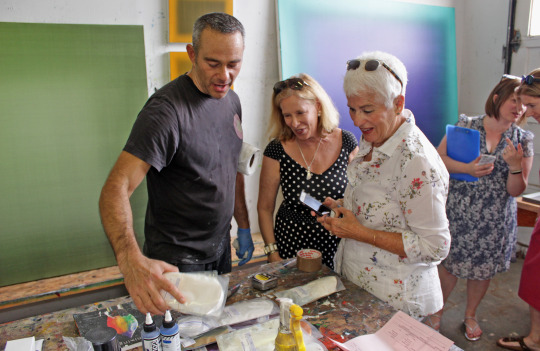
Eric Freeman is an American artist whose monumental, monochromatic oil paintings are rendered in an abstract vocabulary that evokes optical illusions of landscapes. His paintings reference the legacy of Color Field Painting, an art movement hailing—like himself—from New York. Experimentation with color is an integral part of Freeman’s practice; the special glow of his canvases is achieved with bold and unusual color combinations. He has held numerous solo exhibitions throughout the United States and Europe, and his work is included in the collections of Parrish Art Museum in Watermill, NY; Saatchi Collection, London; Frederick R. Weisman Art Foundation, Los Angeles; and the Kiasma Museum of Contemporary Art, Helsinki.
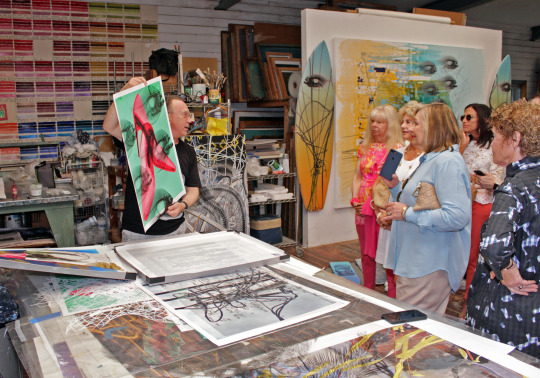
Steve Miller is a multimedia artist who investigates the ways in which art, design, and scientific technology intersect in contemporary culture. His work spans the disciplines of painting, photography, and sculpture, and has played a critical role in pioneering the Sci-Art movement. With more than 50 solo exhibitions at major institutions across the globe—including the National Academy of Sciences, Jack Shainman Gallery, and Hong Kong Arts Center—his work has been reviewed in Le Monde, ARTnews, The New York Times, Artforum, and Art in America, among others. In addition to serving as an editorial advisor and contributor to the photography journal, Musée, Miller is the author of Radiographic(Glitterati, 2017) and the recently-released Surf/Skate: Art and Board Life (Glitterati, 2019). He divides his time between homes in New York City and the Hamptons.
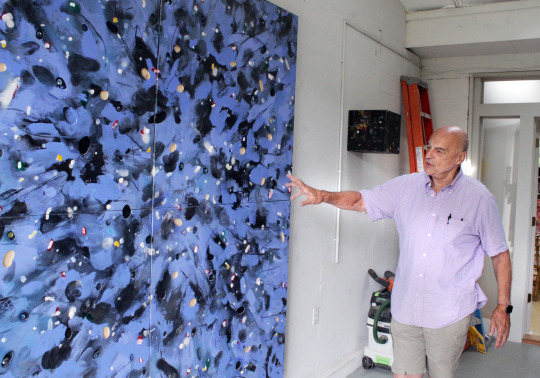
John Torreano discovered the lure of the East End after moving to New York City in 1968. In 1969 he was invited to the Edward F. Albee Foundation in Montauk, and since then he has maintained a connection to the East End. Torreano is known for using gems and other unusual materials to make “cosmologies” that challenge such modernist dogma as Essentialism, with theory and imagery related to astronomy. He has exhibited in galleries and museums including Parrish Art Museum in Watermill, NY; The Museum of Modern Art, New York; The Whitney Museum of American Art, New York; Corcoran Gallery of Art, Washington, D.C.; and the Indianapolis Museum of Art, Indianapolis. Torreano has received the Nancy Graves Foundation Grant for Visual Artists, a John Simon Guggenheim Memorial Foundation Fellowship, and individual grants from the National Endowment for the Arts and the New York State Council on the Arts. His work is represented by The Drawing Room in East Hampton, NY and Lesley Heller Gallery, New York.
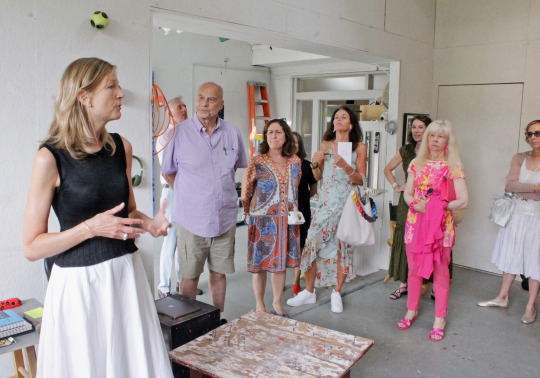
Sign up for NYFA’s bi-weekly newsletter, NYFA News, to receive announcements about future NYFA events and programs.
Images from Top: Attendees gather at a private residence in Bridgehampton following the East End Studio Tour; Eric Freeman, Steve Miller, and John Torreano in their respective studio spaces; and Corinne Erni leading the tour at John Torreano’s studio. All images credit Thomas Kochie for NYFA.
#east end studio tour#eastendstudiotour#hamptons#thehamptons#long island arts#longislandarts#parrish art museum#parrishartmuseum#stevemillerart#steve miller art#John Torreano#johntorreano#eric freeman#ericfreeman#announcements#instagram
0 notes
Photo

26. Januar bis 17. März 2019: Diese erste große Ausstellung der Corcoran Legacy Collection zeigt starke Fotografien und Skulpturen, die @tony.podesta im letzten Jahrzehnt der @corcorangallery of Art gespendet hat, welche jetzt zum Bestand des @americanuniversity Museum gehört. Podesta hat sich den Ruf, ein beherzter Unterstützer der zeitgenössischen Kunst vorrangig von Frauen zu sein. Er ist ein wichtiger Förderer der Künste im In- und Ausland mit übergroßem Einfluss in der gesamten Washingtoner Kunstwelt. Folgende KünstlerInnen werden gezeigt: Darren Almond, Jake & Dinos Chapman, Jenny Gage, Mads Gamdrup, Anna Gaskell, Margi Geerlinks, Siobhán Hapaska, @mwangihutter (in Berlin durch die @galerieburster vertreten), Justine Kurland, Jone Kvie, Clare Langan, Barbara Liotta, Malerie Marder, Ottonella Mocellin, Ernesto Neto, Anneè Olofsson, Gyan Panchal, Nira Pereg, Patricia Piccinini, Torbjørn Rødland, Jenny Rydhagen, Ann-Sofi Sidén, @katjastrunz2018 , Janaina Tschäpe, Hellen van Meene und Tom Waldron. The Gifts of Tony Podesta kuratiert von Jennifer Sakai und Klaus Ottmann 26. Januar 17 Uhr: The Gifts of Tony Podesta Gallery Talk UAwg: museum @ american.edu Host: @American University Museum at the Katzen Arts Center https://tinyurl.com/yaqy8wso (hier: American University Museum) https://www.instagram.com/p/Bs7fJTWlStC/?utm_source=ig_tumblr_share&igshid=f3z09c5p2blr
0 notes
Text
Lois Mailou Jones






Lois Mailou Jones (November 3, 1905 – June 9, 1998) was an artist who painted and influenced others during the Harlem Renaissance and beyond, during her long teaching and artistic career. Jones was the only African-American female painter of the 1930s and 1940s to achieve fame abroad, and the earliest whose subjects extend beyond the realm of portraiture. She was born in Boston, Massachusetts and is buried on Martha's Vineyard in the Oak Bluffs Cemetery.
Early life and education
Her father, Thomas Vreeland Jones was a building superintendent who later became a lawyer after becoming the first African-American to earn a law degree from Suffolk Law School; her mother, Carolyn Jones was a cosmetologist.
Jones' parents encouraged her to draw and paint as a child in water color. During childhood her mother took her and her brother to Martha's Vineyard where she became lifelong friends with novelist Dorothy West. She attended the High School of Practical Arts in Boston. Meanwhile, she took Boston Museum of Fine Arts evening classes and worked as an apprentice in costume design. She held her first solo exhibition at the age of 17. From 1923 to 1927 she attended the School of the Museum of Fine Arts in Boston studying design, taking night courses at the Boston Normal Art School. She also pursued graduate work at the Design Art School and Harvard University. She continued her education even after beginning work, attending classes at Columbia University and receiving her bachelor's degree from Howard University in 1945, graduating magna cum laude.
Work
In 1928 she was hired by Charlotte Hawkins Brown after some initial reservations, and founded the art department at Palmer Memorial Institute in North Carolina. As a prep school teacher, she coached a basketball team, taught folk dancing, and played the piano for church services. Only one year later, she was recruited to join the art department at Howard University in Washington D.C., and remained as professor of design and watercolor painting until her retirement in 1977. While developing her own work as an artist, she was also known as an outstanding mentor.
In 1934 Jones met Louis Vergniaud Pierre-Noel, who would become a prominent Haitian artist, while both were graduate students at Columbia University. They corresponded for almost twenty years before marrying in the south of France in 1953. Jones and her husband lived in Washington, D.C. and Haiti. They had no children. He died in 1982.
In the early 1930s Jones exhibited with the William E. Harmon Foundation and other institutions, produced plays and dramatic presentations and began study of masks from various cultures. In 1937 she received a fellowship to study in Paris at the Académie Julian. During one year's time she produced over 30 watercolors. She returned to Howard University and began teaching watercolor painting. She said of her time in Paris:
The French were so inspiring. The people would stand and watch me and say 'mademoiselle, you are so very talented. You are so wonderful.' In other words, the color of my skin didn't matter in Paris and that was one of the main reasons why I think I was encouraged and began to really think I was talented.
In 1938 she produced Les Fétiches (1938) a stunning, African inspired oil which is owned by the Smithsonian American Art Museum, Jones' Les Fétiches was instrumental in transitioning 'Négritude'—a distinctly francophone artistic phenomenon—from the predominantly literary realm into the visual. Jones' work provided an important visual link to Négritude authors including Aimé Césaire, Léon Damas, and Léopold Sédar Senghor. It was one of her best known works, and her first piece which combined traditional African forms with Western techniques and materials to create a vibrant and compelling work. She also completed Parisian Beggar Womanwith text supplied by Langston Hughes.
Her main source of inspiration was Céline Marie Tabary, also a painter, whom she worked with for many years. Tabary submitted Jones' paintings for consideration for jury prizes since works by African-American artists were not always accepted. Jones traveled extensively with Tabary, including to the South of France, and they frequently painted each other. They taught art together in the 1940s.
In the 1940s and early 1950s Jones exhibited at the Phillips Collection, Seattle Museum of Art, National Academy of Design, the Barnet Aden Gallery, Pennsylvania's Lincoln University, Howard University, galleries in New York and the Corcoran Gallery of Art. In 1952 Loïs Mailou Jones: Peintures 1937-1951, a collection of more than 100 reproductions of her French paintings, was published.
In 1954 Jones was a guest professor at Centre D'Art and Foyer des Artes Plastiques in Port-au-Prince, Haiti where the government invited her to paint Haitian people and landscapes. Her work became energized by the bright colors. She and her husband returned there during summers for the next several years, in addition to trips to France. There she completed "Peasant girl, Haiti" and also exhibited her work. In 1955 she unveiled portraits of the Haitian president and his wife commissioned by United States President Dwight D. Eisenhower.
Jones's numerous oils and watercolors inspired by Haiti are probably her most widely known works. In them her affinity for bright colors, her personal understanding of Cubism's basic principles, and her search for a distinctly style reached an apogee. In many of her pieces one can see the influence of the Haitian culture, with its African influences, which reinvigorated the way she looked at the world. These include Ode to Kinshasa and Ubi Girl from Tai. Her work became more abstract and hard-edged, after her marriage to Pierre-Noel. Her impressionist techniques gave way to a spirited, richly patterned, and brilliantly colored style.
In 1962 she initiated Howard University's first art student tour of France, including study at Académie de la Grande Chaumière and guided several more tours over the years. In the 1960s she exhibited at School of the Museum of Fine Arts, Boston, Cornell University, and galleries in France, New York and Washington, D.C.
In 1968 she documented work and interviews of contemporary Haitian artists for Howard University's "The Black Visual Arts" research grant. And continued the project in 1969 and 1970, traveling to eleven African countries. Her report Contemporary African Art was published in 1970 and in 1971 she delivered 1000 slides and other materials to the University as fulfillment of the project. In 1973-74 she researched "Women artists of the Caribbean and Afro-American Artists."
Her research inspired Jones to synthesize a body of designs and motifs that she combined in large, complex compositions. Jones's return to African themes in her work of the past several decades coincided with the black expressionistic movement in the United States during the 1960s. Skillfully integrating aspects of African masks, figures, and textiles into her vibrant paintings, Jones continued to produce exciting new works at an astonishing rate of speed, even in her late eighties. In her nineties, Jones still painted. Bill Clinton and Hillary Clinton collected one of her island seascapes Breezy Day at Gay Head while they were in the White House.
Jones felt that her greatest contribution to the art world was "proof of the talent of black artists." The African-American artist is important in the history of art and I have demonstrated it by working and painting here and all over the world." But her fondest wish was to be known as an "artist"—without labels like black artist, or woman artist. She has produced work that echoes her pride in her African roots and American ancestry.
Lois Mailou Jones' work is in museums all over the world and valued by collectors. Her paintings grace the permanent collections of the Metropolitan Museum of Art, Smithsonian American Art Museum, Hirshhorn Museum and Sculpture Garden, National Portrait Gallery, Boston Museum of Fine Arts, the National Palace in Haiti, the National Museum of Afro-American Artists and many others.
Awards and honors
Robert Woods Bliss Award for Landscape for Indian Shops Gay Head, Massachusetts(1941)
Atlanta University award for watercolor painting Old House Near Frederick, Virginia (1942)
Women of 1946 award from the National Council of Negro Women (1946)
John Hope Prize for Landscape for Ville d'Houdain, Pas-de-Calais and award from the Corcoran Gallery of Art for Petite Ville en hautes-Pyrenées (1949)
Atlanta University award for Impasse de l'Oratorie, Grasse, France (1952)
Chevalier of the National Order of Honor and Merit from the government of Haiti. (1954)
Award for design of publication Voici Hätii (1958)
Atlanta University award for Voodoo Worshippers, Haiti and America's National Museum of Art award for Fishing Smacks, Menemsha, Massachusetts (1960)
Elected Fellow of The Royal Society of Arts in London; receives Franz Bader Award for Oil Painting from National Museum of Art for Peasants on Parade (1962)
Howard University Fine Arts Faculty Award for Excellence in Teaching (1975)
Honorary Doctorate of Humane Letters from Suffolk University in Boston. She also has received honorary degrees from Colorado State Christian University, Massachusetts College of Art
Honored by President Jimmy Carter at the White House for outstanding achievements in the arts (1980).
Candace Award, Arts and Letters, National Coalition of 100 Black Women (1982)
Legacy
After her death, her friend and adviser, Dr. Chris Chapman completed a book about her life and the African-American pioneers she had worked with and been friends with, including Dr. Carter G. Woodson, Alain Locke, Dorothy West, Josephine Baker, and Matthew Henson. Entitled Lois Mailou Jones: A life in color, it is available through Xlibris and museum stores.
In 1997, Jones' paintings were featured in an exhibition entitled Paris, the City of Light that appeared at several museums throughout the country including the New Orleans Museum of Art, the Milwaukee Art Museum, and the Studio Museum of Harlem. The exhibition also featured the works of Barbara Chase-Riboud, Edward Clark, Harold Cousins, Beauford Delaney, Herbert Gentry, and Larry Potter. The exhibition examined the importance of Paris as an artistic mecca for African-American artists during the 20 years that followed World War II.
From November 14, 2009, to February 29, 2010, a retrospective exhibit of her work entitled Lois Mailou Jones: A life in vibrant colorwas held at the Mint Museum of Art in Charlotte, North Carolina. The traveling exhibit included 70 paintings showcasing her various styles and experiences: America, France, Haiti, and Africa.
Wikipedia
2 notes
·
View notes
Photo



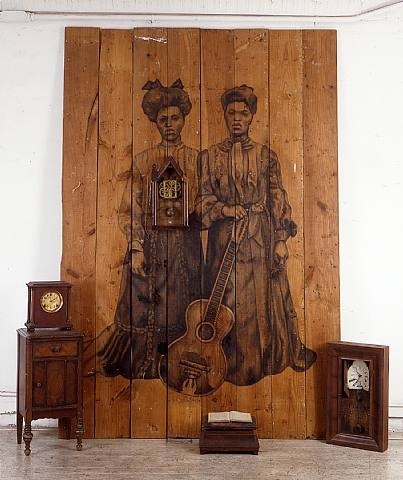
Spotlight: Whitfield Lovell
Whitfield Lovell is a contemporary artist known primarily for his drawings and masterful installations based on vintage photographs of unidentified African Americans from the first half of the 20th century (usually between the Emancipation Proclamation and the Civil Rights Movement).
Lovell creates these drawings in pencil, oil stick, or charcoal on paper, wood, or directly on walls. In his most recent work, these drawings are paired with found objects that Lovell collects at flea markets and antique shops – with these found objects he evokes personal memories, ancestral connections, and the collective American past.
Lovell’s work illuminates the humanity and richness of anonymous people, engraining their legacies in our cultural memory.*
The More You Know:
Works by Whitfield Lovell are featured in major museum collections including The Whitney Museum of American Art, NY; The Metropolitan Museum of Art, NY: The Corcoran Gallery, Washington, DC; The Smithsonian American Art Museum, DC; The Smithsonian National Museum of African American History and Culture, DC; Pennsylvania Academy of the Fine Arts, PA; The Yale University Art Gallery; The Hunter Museum of American Art, Chattanooga, TN; The Brooklyn Museum, NY; The Studio Museum in Harlem, NY; Seattle Art Museum, WA, and many others.
*information culled from Whitfield Lovell’s bio.
110 notes
·
View notes